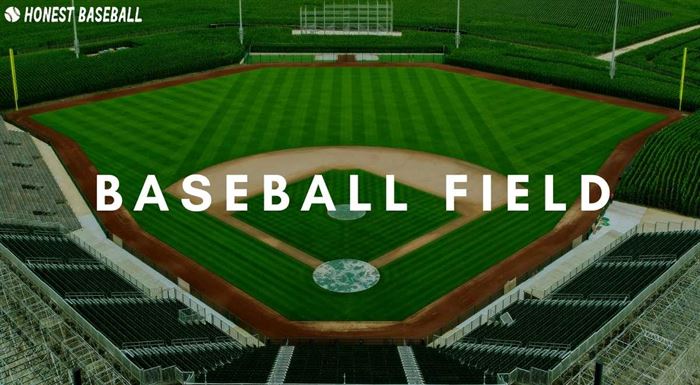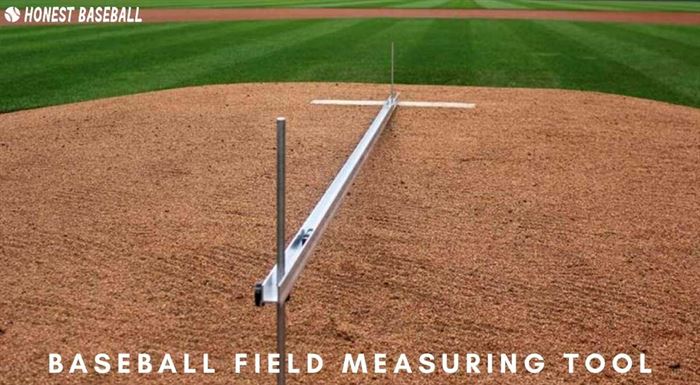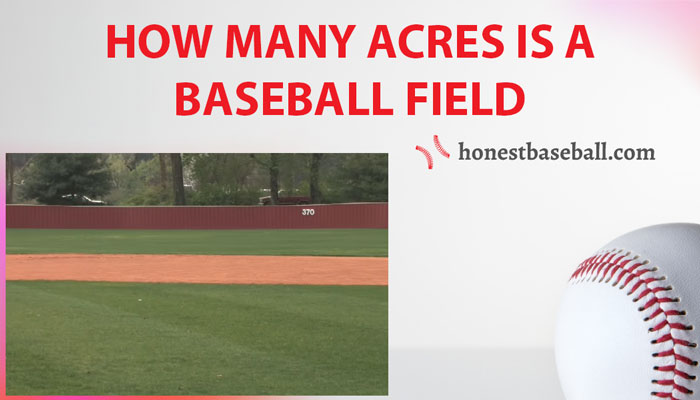You went to your first baseball game at the ball park and, amazed at the baseball diamond, you ask yourself how many acres is a baseball field? When I entered a major league baseball field, I had the same question in my mind.
Since that day, I have seen many ball parks. Every time I visit a ball field, either for playing or coaching, I wonder how many acres it will be. By the year of experience, I can now assume the size of the playing field just by taking a glance at it.
We will look at how many acres and square feet go into building a baseball field. So, let us get started.
Baseball Field Typical Space
You will not see a baseball field, unlike those in other sports. The dimension of the baseball field greatly relies on the baseball league you are competing in.
This is why the length from home plate is marked on the left, center, and right field boundaries in major league stadiums. If these lengths were standard, they would not paint it.
For a baseball field, you will need approximately three acres of land that is 400 feet long by 400 feet wide.
A typical baseball field is almost twice the size of a softball field. To give you an idea, an acre is about the size of an American Football Field.
There are a number of variables that go into determining the size of a baseball field, including the amount of available land.
Nonetheless, the standard baseball field with a 400-foot fence is 4.5 acres in size. This is about double the area of a softball field with a 275-foot fence, which is 2.5 acres.
As an additional point of consideration, we do not only focus on the diamond. Everything on the lot, from the parking spaces to the seating for the fans, is part of the growing baseball fields.

How Many Square Feet
We already know that an average baseball field is approximately three acres. How many square feet do baseball and softball overlap in terms of playing area? The measurement below is the whole ball park, instead, it’s just the playing surface
Baseball field typical space needs
| Serial | Bases | Fences | Acres |
| 1 | 90′ | 400′ | 4.5 |
| 2 | 80′ | 315′ | 3.0 |
| 3 | 70′ | 275′ | 2.0 |
| 4 | 60′ | 215′ | 1.5 |
Softball field typical space needs
| Serial | Bases | Fence | Acres |
| 1 | 65′ | 275′ | 2.5 |
| 2 | 60′ | 200′ | 1.5 |
All told, an average ballpark is 36,000 square feet of space. This is roughly three quarter of an acre in size.

How To Measure A Baseball Field
You need precise measurements to build a baseball field or do research. Keep in mind that all baseball fields are not the same size.
Consider the following guidance:
Backstop- Trangulated
an excellent place to locate the home plate apex is when there is no backstop. You can extend a thread to measure where you anticipate the pitching rubber.
Make a note of the length of the first thread, and then repeat the procedure.
Next, take a measurement and mark the backstop’s center. To get to the intersection of the arcs, draw a straight line out from this point. Place the home plate on this line at a predetermined distance from the backstop, based on the field.
Second Base Location
Line up the second base with the backstop’s center point, the apex, and the pitcher’s mound.
Position First and Third Bases
From the top, measure how far the third base is from the baseline and draw an arc. Scribble another arc from the middle of second to third base.
The base should be positioned to cross at the outer rear corner where the arcs intersect. Repeat this process until you find your first base.
Set the Home Plate
Connect the outer rear corners of the third and first bases to the peak. Align the home plate’s back angles with these lines.
Set Pitching Rubber
Using a tape measure, find an equal space at each corner of the home plate and the throwing rubber to square it up. Determine and indicate the correct distance between the home plate and the pitching rubber.

Why Do Baseball Field Dimensions Vary?
All baseball fields are not the same size as the National League Parks tend to be bigger. Major league ballparks have never been standardized in terms of their dimensions for technical and cultural reasons.
Rather, the outfield fence lengths and other minor details vary greatly. There are not any set guidelines for constructing grounds.
I think the size of a baseball field depends on several factors:
Pitching Distances
The distance from the pitcher to the batter begins at 46 feet for younger players. It gradually increases up to 60 feet and 6 inches for MLB. Young kids can not throw far or hard, so it begins close.
It becomes easier for them to toss the ball as they become older and stronger. Keeping the batter at 46 feet would make it impossible for him to strike the ball. The hitter’s response time is more important than the length of the pitching rubber.
Routing Paths
Little League bases are 60 feet long, great for smaller, slower players. Starting with an infield that is too broad will make it impossible for infielders to make the throws from one base to the other. As children get older, the distance between the bases increases from 60 to 70 to 80 to 90 feet.
Home Run Fence
A home run is one of the most exciting events in a baseball game. Due to costs and other circumstances, many Little League grounds lack suitable fences, but those that do have 200-foot fences. This results in a field size ideal for youngsters to run about and play defense, as well as an accessible fence for the stronger hitters.
Frequently Asked Questions
1. How Much Does it Cost to Build a Baseball Field?
Before calculating the cost to build a baseball field, it is important to know that several parameters contribute to the overall cost of the average ballpark. The ultimate product’s size, quality, and design are all included in these factors.
If you add more features and facilities to a stadium, it would drastically raise the price. You will see that constructing a baseball field costs $15,000 to well over $1 million. You should also take a good look at the material and the labor work, as it also adds weight to your total cost.
2. What are the Largest Baseball Fields?
A standard field size helps to fit the diamonds, dugouts, spectator seats, and parking lot of baseball grounds, which are all the same. Despite this, a few baseball fields are so enormous that they tower over their surroundings.
As with their sizes, the expenses of developing a baseball field vary based on the size of the field and other variables. There are still a few stadiums that tower above others, such as Dodger Stadium and Fenway Park, which have a capacity of more than 50,000.
Some of these major league fields include
- Dodger Stadium (Capacity: 56000)
- Coors Field (Capacity: 50,144)
- Rogers Centre (Capacity: 49,282)
- Chase Field (Capacity: 48,686)
- T-Mobile Park (Capacity: 47,929)
3. Is Minor League baseball considered professional?
Minor league players are paid far less than their big league counterparts; they are considered professional athletes. The baseball cards’ terms “pro record” and “pro seasons” relate to a player’s career in the big and minor leagues, respectively.
4. How Big Is a Tee Ball Field?
Tee-ball players range from four to six, making this the greatest method to introduce them to baseball without overwhelming them. Tee-ball does not often have a home run barrier. However, the bases are separated by 50 feet. Here are some of the best tee ball bats to help you score a home run.
5. What Are the Dimensions of a Little League Baseball Field?
From the pitcher mound to home plate, a typical standard Little League field is 46 feet, while the distance between the bases measures 60 feet. The home run wall should be 200-275 feet from the home plate.
Conclusion
Now, when someone inquires how many acres is a baseball field, you will be prepared to wow them with your insight. When playing away from home, knowing the baseball field’s acres can help you calculate the distance of the diamond.
Baseball fields can range in size from massive sizes to little playgrounds. A 90-foot stadium requires a lot of areas, particularly to hold a large number of spectators.
Now, start practicing running, hitting, pitching alone, and proper sliding as you may not get the same sized baseball diamond everywhere. Good luck with your next game.
You Might Also Like
How To Teach Sliding in Baseball In Proper Ways
How Are Baseball Pants Supposed To Fit Like Pro Players!
Learn How To Play Catcher In Baseball Like A Pro

Hello everyone. My name is Jason Butler, and I live in California, America. I was a professional AAA Minor League Baseball player. I lost my chance of playing MLB for injury issues, but I did not lose my love for baseball. I attended the coaching training program and am now working as a coach in a small school in San Diego.
I always love to share my experience and knowledge if that can help you. Play baseball, and stay fit.
